Report on Joint Research Findings
Fiscal 2022
Principal Research
1. A Study on the Collection of the Autographed Manuscripts of Minoru Betsuyaku
2. Research on the Kurabayashi Seiichiro materials
3. Research and Study Toward the Utilization of Film-related
Materials Centered on Theater Flyers
Selected Research
1. Dance during the Wartime and the Postwar Period,
Seen Through the Eguchi Hiroshi Materials
2. The Literary Circles of the Middle Edo Period,
Focusing on Approaching Kabuki Performers Through Diaries
3. Empirical Research on Regional Theatre Under the
GHQ (SCAP) Occupation: Focusing on the Kyushu Area
4. Research on Musicians and Musical Bands through
Kurihara’s Musical Score Collection: Music for Stage and Cinema during the Early Showa Era
5. Publishing Activities of the Sakagawaya, Publisher
of the Original Tokiwazu-bushi
Principal Research 1
A Study on the Collection of the Autographed Manuscripts of Minoru Betsuyaku
Principal Researcher
Umeyama Itsuki (Associate Professor, Department of Performing Arts, Faculty of Literature, Arts and Cultural Studies, Kindai University)
Collaborative Researchers
Okamuro Minako (Professor, Faculty of Letters, Arts, and Sciences, Waseda University, and Director, Theatre Museum, Waseda University)
Miyamoto Keiko (Part-time Lecturer, Shirayuri University)
Research Objectives
The purpose of this study is to examine Betsuyaku’s style as a playwright and character representations in his works, through a survey of material donated by Betsuyaku’s family as well as documents concerning Betsuyaku’s work which are maintained by the Theatre Museum. The topic study of the same title adopted in AY2020 investigated documents related to Betsuyaku’s early works, revealing keywords important to understand the core of Betsuyaku’s work, including silence, poverty, hatred, and self-sacrifice. Furthermore, interest in literature other than plays, such as the works of Miyazawa Kenji and Fukazawa Shichiro, had a significant influence on the formation of Betsuyaku’s style as a playwright. Here, research from AY2022 on has organized the shifts in style from the 1970s onwards as well as working to clarify how Betsuyaku’s interest in literary works such as those of Miyazawa and Fukazawa, nursery rhymes, and ancient poetry was reflected in his writing.
Summary of Research
This academic year was mainly used for a survey of unsorted documents and an investigation of the changes
in the characteristics of early works from the 1970s onwards. First, through cooperation from Theatre Museum curators, all the materials were catalogued, reaching to approximately 2300 records. Among these, handwritten drafts constituted 73% of the whole. Of these, 57% were essays and critiques, followed by 30% drama-related material. In addition, 7% of the drafts had no identifiable title, whereas others had identifiable titles but were discovered in scattered form. In this year, the study involves photographing the drafts requiring further investigation and examining them within the team. Furthermore, we are photographing the handwritten Betsuyaku drafts donated by a publisher and checking whether they contain unpublished material.
Regarding shifts in style, Umeyama compiled the research outcomes in a paper submitted to Engeki Kenkyu [Studies in Dramatic Art]. The paper first notes the source of Betsuyaku’s creative work in the emotion of hatred, based on early drafts of Hokuro Sausage as covered in topic research thus far. In this play, the “town” community exposes hatred toward its residence through violence. The paper touches on the major early works Elephant and Landscape with Red Bird to argue that the community’s violence is transformed into kindness and caring. Also, it focuses on the relationship between the community and the individual in the 1970s The Soyosoyo Tribe Rebellion, concluding that the community’s transformation can be grasped as a sign of the shift in Betsuyaku’s interests from depicting hatred for the invisible structure of discrimination to exposing the framework of this structure.
Therefore, this academic year’s research outcomes include the clarification of the materials as a whole and the organization of research results on early works as a paper. However, as research into the influence of literary works, nursery rhymes, and ancient poetry on Betsuyaku made insufficient progress, it remains as a task for the following academic year.
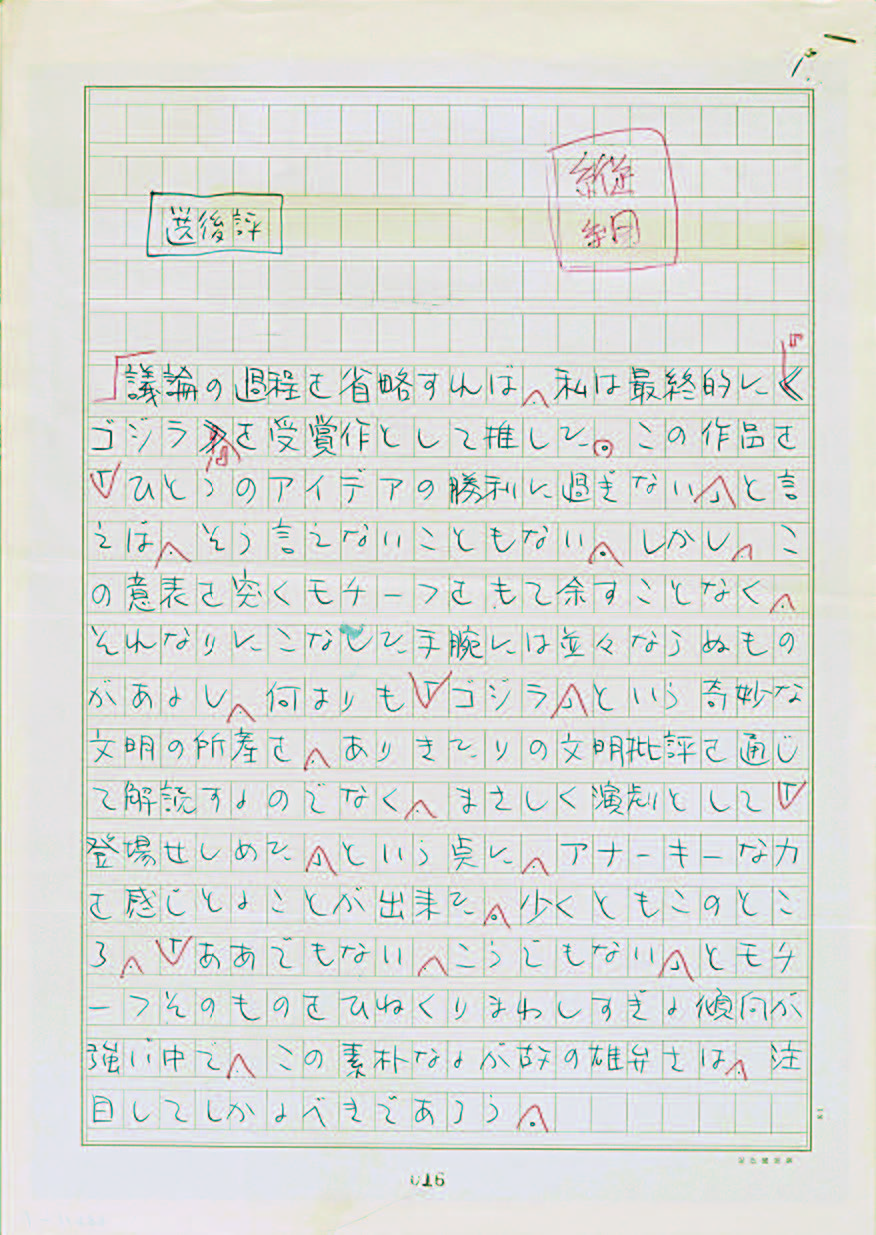
Selection Review on the 32nd Kishida Kunio Drama Award, 1988[66211]
Principal Research 2
Research on the Kurabayashi Seiichiro materials
Principal Researcher
Goto Ryuki (Associate Professor, The Edogawa Rampo Memorial Center for Popular Culture Studies, Rikkyo University)
Collaborative Researchers
Kamiyama Akira (Emeritus Professor, Meiji University)
Yoneya Naoko (Cultural policy and arts management advisor)
Research Objectives
Kurabayashi Seiichiro (1912-2000), who joined the Haiyu-za Theater Company in 1946, immediately after World War II, established the Haiyu-za Theater in 1956 and became its CEO in 1981. He was also involved in the establishment of the Japan Council of Performers Rights and Performing Arts Organizations (Geidankyo), Japan’s first umbrella organization for performers in 1965, as an influential figure in the protection of stage performers’ rights, support for cultural activities, and policy proposals. Through investigation and examination of the Kurabayashi holdings, previously unorganized and undisclosed, this study reevaluates Kurabayashi as a playwright and creates a foundation for basic research on postwar theater.
Summary of Research
In this academic year, we started by unpacking the boxes containing a vast quantity of materials, to confirm, sort, and investigate the contents. For specific investigation, with the help of Fujiya Keiko, Miyoshi Tamaki, and Sakuma Satoshi (the research collaborators), we started to sort and classify the materials by type, recording them, and creating a catalog.
A wide variety of materials were identified in sequence; subsequently, we selected the following materials to be sorted out and investigated.
(1) Material on the Shingeki (New Drama) performance in China: Material regarding the Shingeki performances in China (1960) involving the Bungaku-za, Mingei, Tokyo Geijutsu-za, Budo-no-kai, and Haiyu-za, covering diverse performance-related documents such as records in Kurabayashi’s handwriting, a manuscript draft of Umi no sachi (synopsis) by Murayama Tomoyoshi, the group leader, a shorthand record of the discussion with local theater personnel, and so on. The purpose of this survey was to address the content and significance of these performances.
(2) Mizuho Theater journal: A journal of the performances of the wartime touring Mizuho Theater (Rural Culture Association), which Kurabayashi accompanied as a clerk. This material reveals the daily life and tour activities of wartime touring theaters, as well as their performance content and reception. Comparison with records of other touring theaters will provide important clues for overall consideration.
Research outcomes include a survey on Kurabayashi Seiichiro's work as a foundation for research, based on the Kurabayashi holdings and related materials; subsequently, Goto Ryuki published the study as “A foreword to Kurabayashi Seiichiro studies: Preparatory discussion of Shingeki history as seen by a playwright” (Rikkyo Institute of Japanese Studies Annual Report Vol. 21, August 2022). In order to examine the history of Shingeki from the playwright’s perspective, based on an evaluation of Kurabayashi’s writings, the positioning of the playwright in performance history, and previous research history, this paper focuses on Kurabayashi’s career before joining the Haiyu-za. It organizes how he became a playwright and his encounter with theater (Shingeki), creating a foundation for research on Kurabayashi and on the postwar history of Shingeki.
In addition, given that Kurabayashi provided many policy proposals at the Geidankyo for many years, and that 2022 is the 10th anniversary of the Theater Act, in order to further research on connections between Kurabayashi’s work and contemporary issues, a symposium entitled “What the Theater Act Has Wrought: The 10th Anniversary and the 3-Year Pandemic” was held at Rikkyo University on September 2, 2022. The speakers were Takahagi Hiroshi (Director, Setagaya Public Theatre), Miyagi Satoshi (General Director, Shizuoka Performing Arts Center [SPAC]), Uchino Tadashi (Professor, Gakushuin Women’s College), Yoneya Naoko (collaborative researcher on this project), and Uchida Yoichi (cultural journalist), with Goto serving as overall coordinator. The aim was to explore Kurabayashi’s thinking by moving backward from the contemporary perspective in the field.
In the future, through a thorough examination of the materials in the abovementioned points (1) and (2), the project was to clarify their content and, through excavation and investigation of other materials, research Kurabayashi’s work and the dynamics of postwar Shingeki.
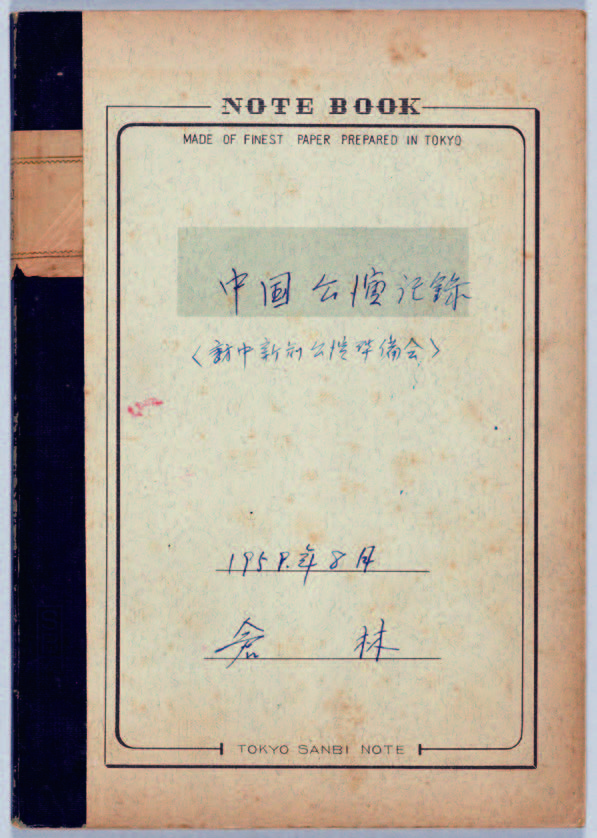
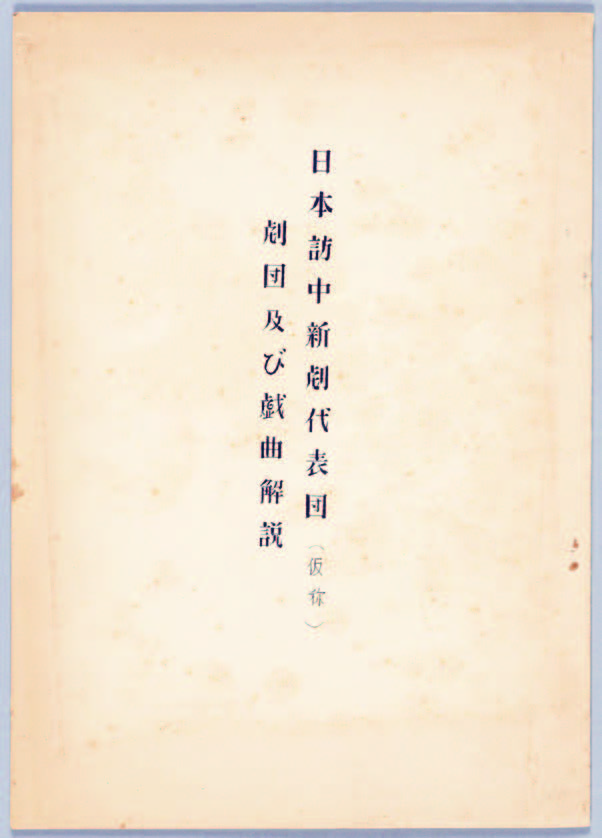
(L) Kurabayashi Seiichiro,“ Record of the China performances [Preparative Committee for the Shingeki China Performances],” September 1958[66267]
(R) Japan Shingeki Representatives to China (tentative name)/Discussion of the theater company and the plays[66272]
Principal Research 3
Research and Study Toward the Utilization of Film-related Materials Centered on Theater Flyers
Principal Researcher
Okada Hidenori (Chief Curator, National Film Archive of Japan)
Collaborative Researchers
Kamiya Makiko (Part-time Lecturer, Musashino Art University)
Shibata Kotaro (JSPS Research Fellow PD)
Research Objectives
In recent years, film studies in Japan and worldwide have performed revisionist research on film history from the perspective of film exhibitions. However, given that the silent film era, with its live vocal and musical performances, has not yet been sufficiently historicized, this study is an empirical survey of cinema exhibitions through cataloging and analysis of cinema flyers held by the Theatre Museum. Furthermore, the study builds on the survey conducted on urban Tokyo cinemas as Selective Research in AY2020-2021, taking up a new focus on other cinema flyers in Tokyo and the Kansai region toward comparative research on cinema exhibitions in East and West Japan.
Summary of Research
In this academic year, in addition to further investigation of the 600 flyers that have been the research subject since AY2020, the team began cataloging 93 new flyers from Tokyo and 137 from Osaka. The process involves the detailed selection and recording of the written text information—with an eye to future utilization; thus, although it required a significant amount of time, the goal of first-stage input was achieved. As the team grasp an overall view of the flyers, it is confirmed that they provide an ideal overview of the diversity of early Showa-era cinemas, from the advertising methods (mainly among the Osaka materials) used as differentation from first-run theaters to the diverse non-film attractions offered. These materials are important in highlighting the changes in theater programs at the time of the shift from silent films to talkies.
Presentations of the survey outcomes include a panel at the 16th Annual Conference of the Association for Studies of Culture and Representation (held at Tokyo Metropolitan University on July 2, 2022), composed of collaborative researchers Shibata Kotaro and Kamiya Makiko and research collaborator Shirai Fumito (Nagoya University of Foreign Studies), on “Texts and Contexts in Taisho-era Cinema(s): Film Promotion Materials.” Individual presentations contributed to further development of the survey topics of the previous academic year, such as the transformations of cinema exhibitions and the film distribution structure in Tokyo, intertextual consideration of the movie Goro Masamune Koshiden (1915), and aural elements of silent-era German films and its music as well as their distribution in Japan and elsewhere; the presentations were followed by a discussion among the participants and the commentator, Ueda Manabu (Kobe Gakuin University).
On February 27, 2023, at the end of the academic year, a joint seminar was held with the selected research project “Research on Musicians and Musical Bands through Kurihara’s Music Score Collection” (principal researcher Nakano Masaaki) at Nagoya University of Foreign Studies. As well as sharing future research issues, this seminar discussed cinema and music from various perspectives, taking into account the new research interest, that is, regional cinema exhibition.
The team also held a workshop at the Theatre Museum on September 7, 2022, to consider further research use of film-related materials. In this workshop, Honchi Haruhiko, a scholar of Japanese film history, lectured on “Collecting and Studying Early Film Materials.” After the lecture, participants exchanged opinions on the collection and use of early film promotion materials occurred while viewing several dozen pieces from Honchi’s collection.
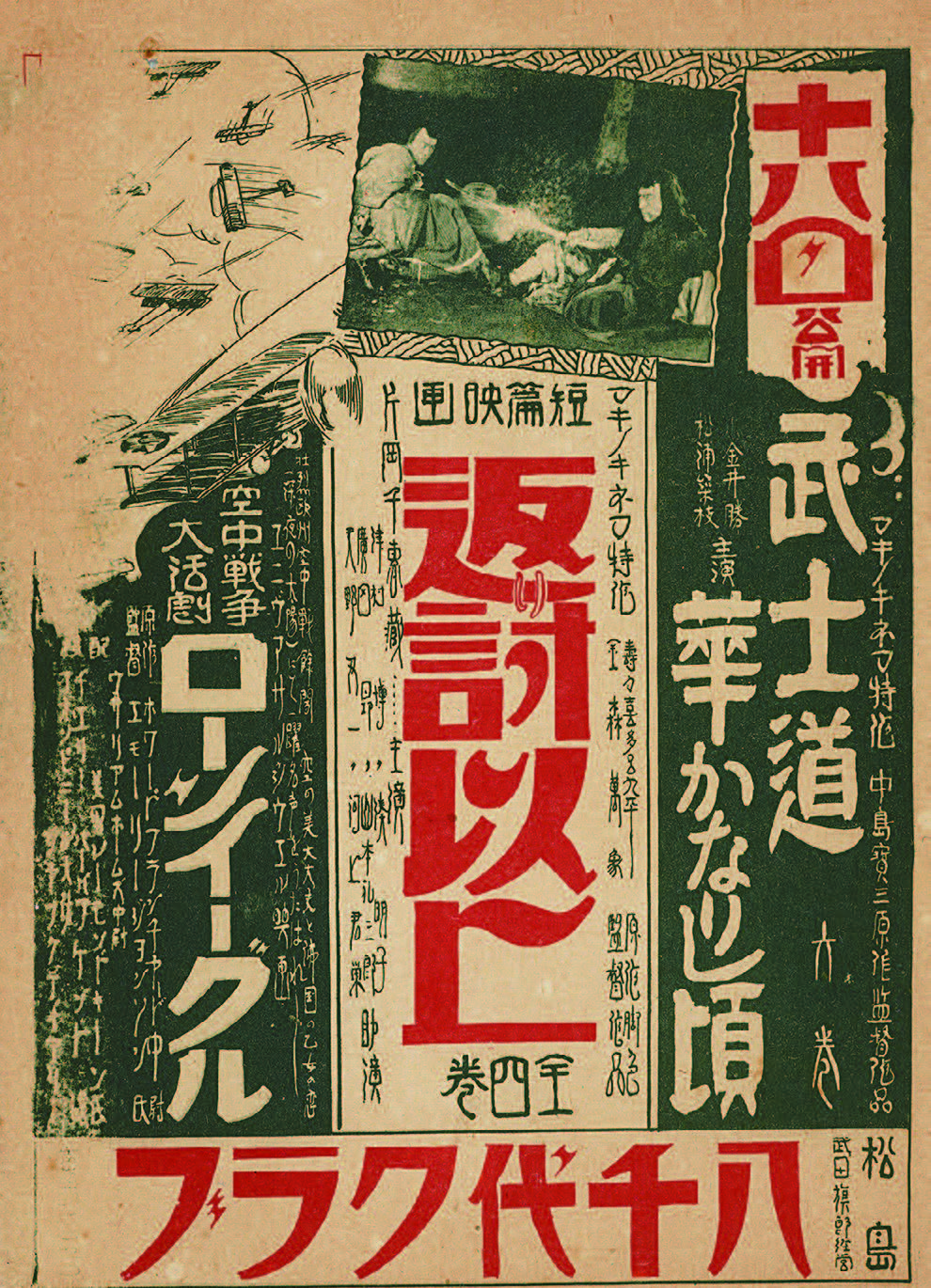
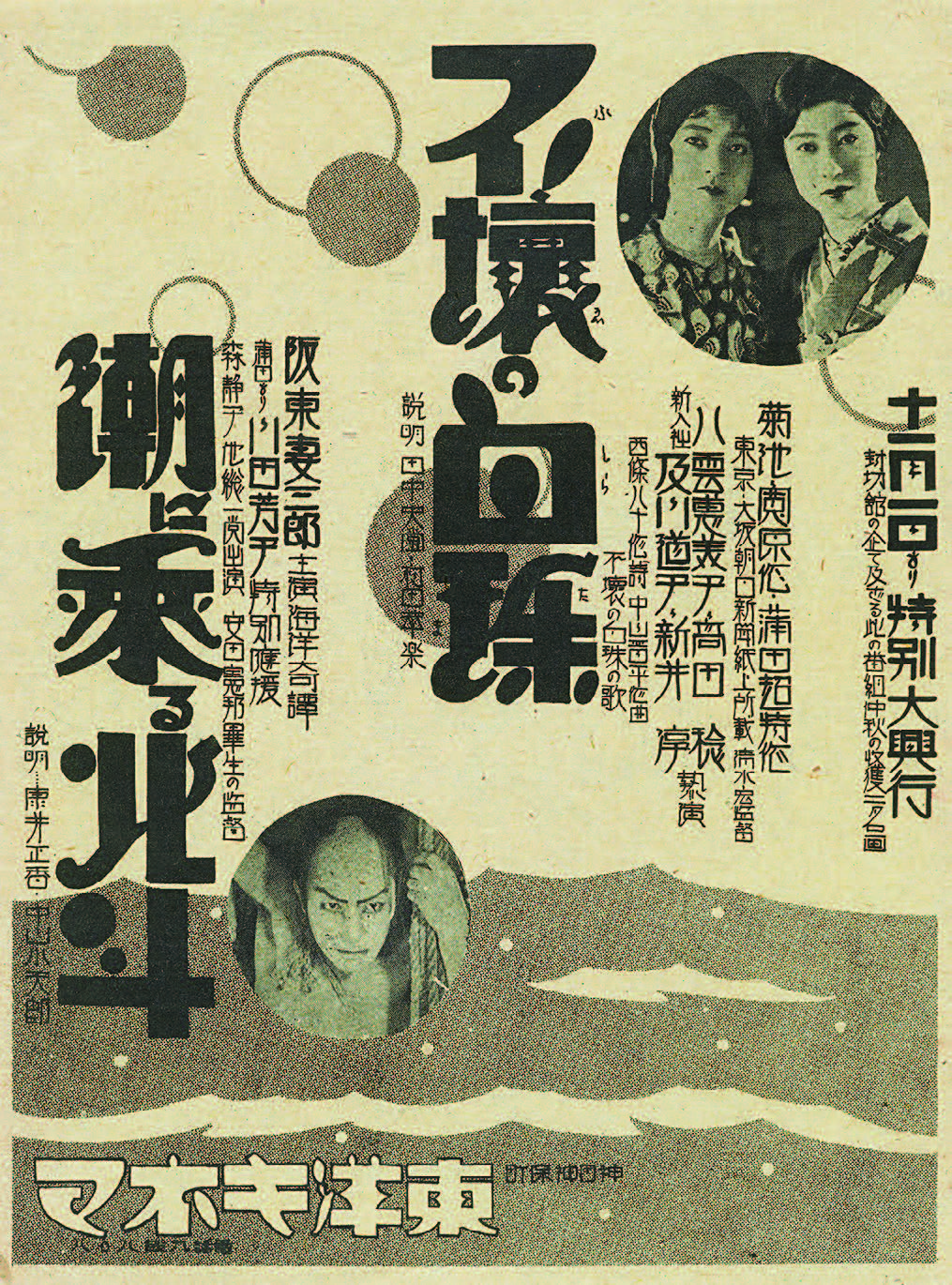
(L) Flyer of Yachiyo Club in 1928[NFM601204]
(R) Flyer of Toyo Kinema in 1929[NFM600983]
Selected Research 1
Dance during the Wartime and the Postwar Period, Seen Through the Eguchi Hiroshi Materials
Principal Researcher
Miyagawa Mariko (Assistant Professor, Department of Body Expression and Cinematic Arts, College of Contemporary Psychology, Rikkyo University)
Collaborative Researchers
Kitahara Mariko (Adjunct Researcher, Theatre Museum, Waseda University)
Lamolière, Maëva (Doctoral Program, Department of Dance, the University of Paris 8)
Research Objectives
The objectives of this study are to survey the “Eguchi Hiroshi Holdings” (280 items, mainly photographs and newspaper clippings related to dance) and to depict the Japanese dance scene throughout the politically tumultuous Showa era. Eguchi Hiroshi (1903-1982) was a dance critic for half a century, from the prewar through postwar periods. The investigation of these materials is expected to provide a new perspective on 20th-century Japanese dance history, which has so far focused on renowned dancers. This study takes particular note of the plentiful materials from the 1930s and 1940s, during and surrounding World War II. Through the Eguchi materials’ broad and meticulous records of the dance scene during this period, a more detailed understanding of the transformations of the dance scene can be obtained.
Summary of Research
〇 Characteristics of the Materials
The material can be divided into the dance photographs owned by Eguchi Hiroshi, newspaper clippings mainly including his own theater reviews, and reference materials such as performance programs. Eguchi joined the culture department of the Kokumin Shimbun (later Tokyo Shimbun) in 1928, beginning to write dance reviews around 1930. His sphere expanded to include a dedicated dance column in the Ongaku Shimbun (a music newspaper founded in 1931), and he continued to write in various periodicals and media until just before his death. Eguchi is notable for his continuous, comprehensive observation of and writing on dance as a newspaperman, and for his wide range of familiarity from Western to Japanese dance.
Eguchi’s activities were not limited to writing dance reviews, he also wrote for performance programs, served as advisor and director for dance-related organizations, and judged competitions. Furthermore, he was invited by the Agency for Cultural Affairs and local governments to take part in councils of experts. He received a Medal of Honor with purple ribbon in 1971 for his overall contributions to the art of dance. Similarly, the materials suggest the breadth of his activities.
〇 Research Outcomes for This Academic Year
Owing to the fact that this was the first year of the study, it began with grasping the specific content and nature of the Eguchi Hiroshi holdings. During this process, the abovementioned characteristics became clear once again. Therein, Eguchi’s long career and meticulous collection of materials are symbolized by the scrapbook of clippings on Ito Michio. Going back as far as an introduction of Ito’s activities overseas from 1917, the collection spans the prewar and postwar years to provide a glimpse of Ito’s profile. The materials were photographed and digitized.
In addition, the other material digitized this year included a statement of intent, program draft, and program selections (classical theater) report for the performances of the Japan Central Cultural League’s 2600th Anniversary of Imperial Japan Celebrations. This material provides an overview of the event, which draws attention in recent years with reference to dancers’ work during the war.
Based on the abovementioned surveys, cataloguing work was subsequently initiated. In addition, a presentation of research outcomes and this year’s survey of the collection was held on January 28, 2023. After an overview of the materials and Eguchi Hiroshi provided by Kitahara Mariko, Miyagawa Mariko reported on dancers’ work during the war, and Maëva Lamolière gave a presentation based on her doctoral thesis, shortly to be submitted, concerning women dancers’ bodies and revues.
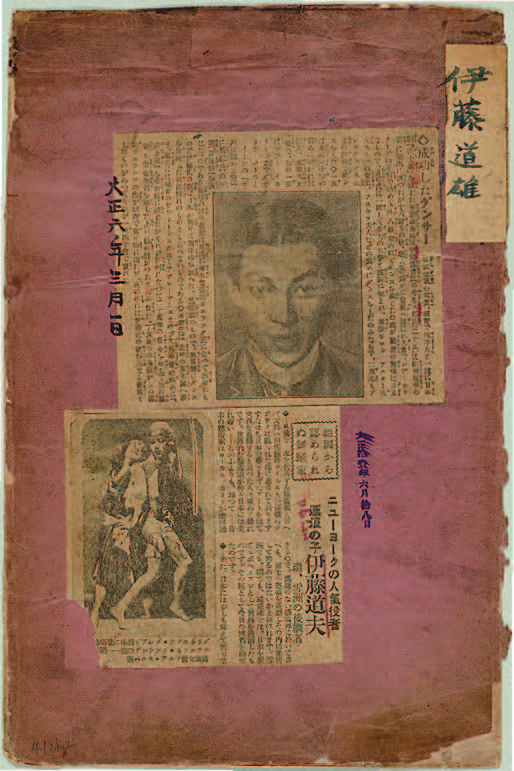
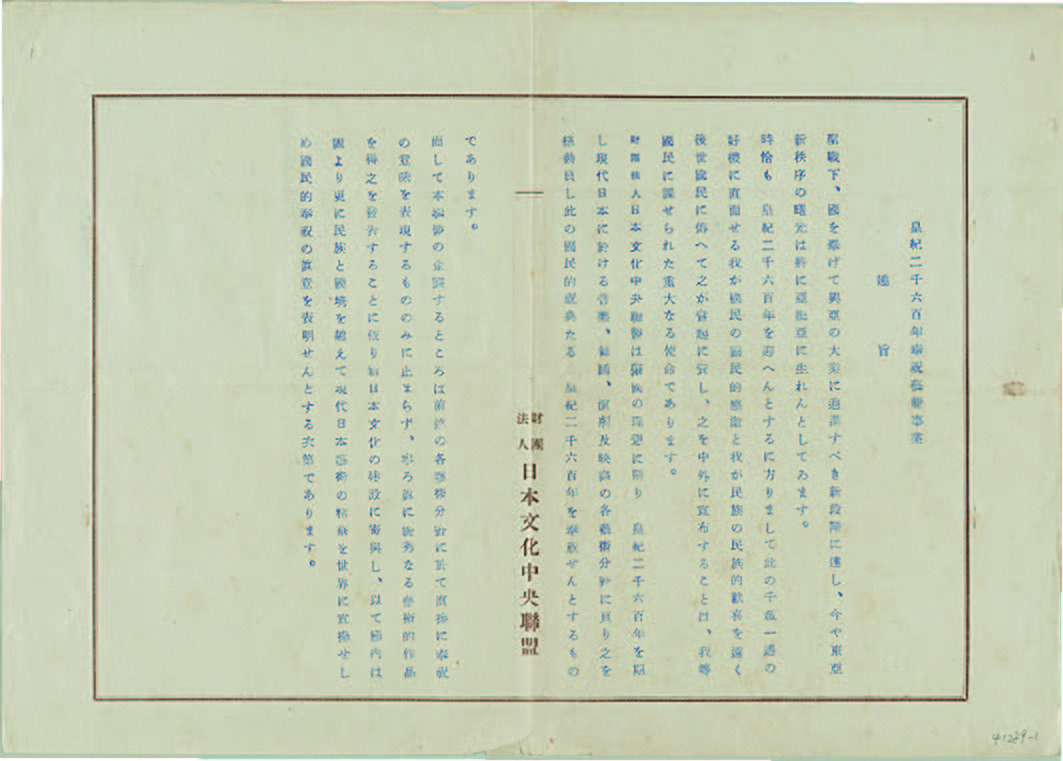
(L) Ito Michio materials[41282-001]
(R) Japan Central Cultural League’s 2600th Anniversary of Imperial
Japan Celebration performance statement[41289-001-001]
Selected Research 2
The Literary Circles of the Middle Edo Period, Focusing on Approaching Kabuki Performers Through Diaries
Principal Researcher
Björk, Tove Johanna (Professor, Saitama University Graduate School of Humanities and Social Sciences)
Collaborative Researchers
Inaba Yusuke (Associate Professor, Wako University Faculty of Liberal Arts)
Hioki Takayuki(Associate Professor, School of Information and Communication, Meiji University)
Research Objectives
Taking the newly discovered “Diary of Ichikawa Danjuro Hakuen II”—i.e., the diary text or “Hakuen Diary”—into consideration, the objectives of the present study include (1) the examination of the provenance and authenticity of the material; and (2) clarification of the literary circles of the middle Edo period, focusing on kabuki performers. The Hakuen Diary, along with the Kakibyoshi Diary, was copied by the doctor of the kyoka parody poet Shikatsube no Magao and his son. After the loss of Danjuro II’s diary to fire in the early Bunka period, it constitutes an important document as a record of the daily lives of kabuki performers in the middle Edo period as well as the literary sphere in which they lived. With this diary as a starting place, this study intended to clarify the Kyoho-era kabuki actors’ connections to haikai poets and other literati in order to clarify the social importance of the literary circles the actors participated in.
Summary of Research
〇 Preparation and Material Collection
The main activity in AY2022 involved gathering materials. The lead researcher and others assigned to the task digitalized and, based on image data, began analysis of the Hakuen Diary and the notes to the Kakibyoshi Diary and Hakuen Diary recorded among the Writings of the Late Hakuen (copied 1917) by Ihara Seiseien, as well as related materials including the Meiwa Gikan (1767), which introduces Meiwa-era kabuki theater personnel, kabuki performers, shibai-jaya theater teahouses, kyogen playwrights, and theater musicians, among others, along with the Danjuro VII Chakuson (1800), which presents Kansei-era kabuki performers’ haiku and records of the work of the line of Danjuro performers.
〇 Analysis and Research
Based on analysis of the materials above, the lead researcher, Tove Björk, analyzed the cultural exchange among Danjuro II and Kawarazaki Chojuro, head of the Kawarazaki-za theater, Rigo the doorman of the Nakamura-za theater, the comic actor Tsuruya Namboku I performing at the Ichimura-za theater, Daikokuya Kusaemon of the Fukiya-cho shibai-jaya teahouses, the bookstore owner Suharaya Seijiro, and the painter Hanabusa Itcho, among others. These exchanges were presented in the research series annotating the diaries of Ichikawa Danjuro II “Nidaime Ichikawa Danjuro nikki shokai: Dai-6-kai Kyoho 19 (1734)-nen 5-gatsu 19-nichi-29-nichi [Reading the diaries of Ichikawa Danjuro II in detail: Part 6, May 19 to May 29, 1734]” (Saitama Daigaku (Kyoyo Gakubu) Kiyo [Saitama University Faculty of Liberal Arts Review]). This series of annotations, which began in 2014, is to continue clarifying the content of Kyoho-era cultural exchange based on Danjuro II’s diaries.
In September 2022, the assigned researcher, Inaba Yusuke, set up the diaries of Danjuro II and prepared for even deeper analysis of the interchange among poets at the Edo-za theater and kabuki performers. From here on, in addition to the diaries, the study will strive to clarify the state of the middle Edo-era literary sphere, focusing on kabuki performers, through books of poetry as well.
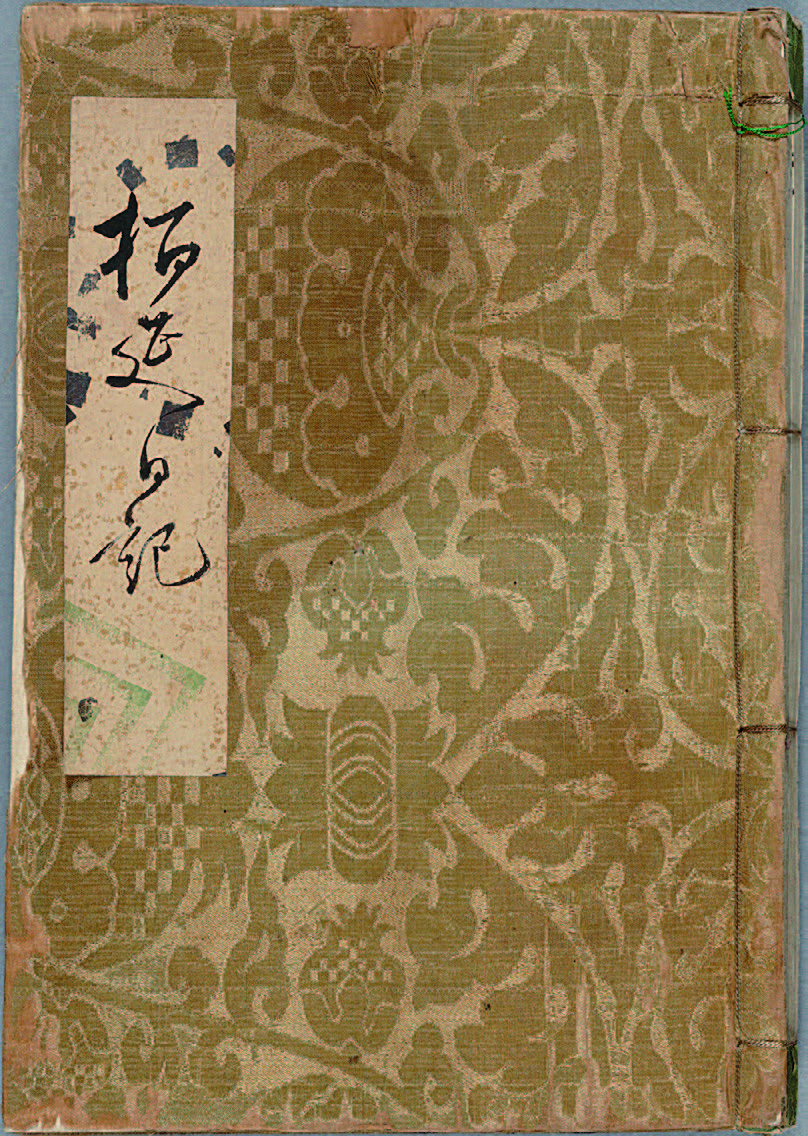
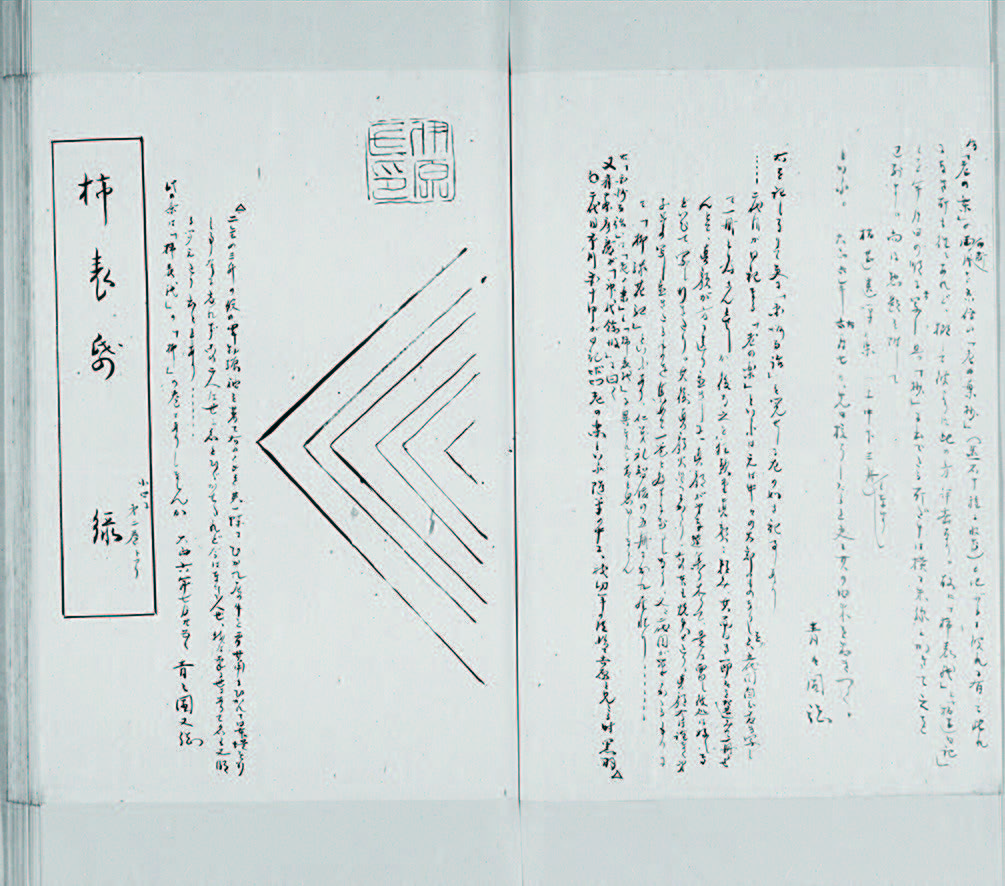
(L) Newly discovered (2015) diary “Diary of Ichikawa Danjuro Hakuen II”[43236]
(R) Writings of Hakuen, including copies of the Kakibyoshi diary and
Hakuen diary[113-00051]
Selected Research 3
Empirical Research on Regional Theatre Under the GHQ (SCAP) Occupation: Focusing on the Kyushu Area
Principal Researcher
Ogawa Chikashi (Professor, Faculty of Childhood Education, Yokohama Soei University)
Collaborative Researchers
Sugawa Wataru (Associate Professor, Faculty of Humanities, Fukuoka Jo Gakuin University)
Hatanaka Sayuri (Part-time Lecturer, Osaka University)
Research Objectives
The objective of this study was to clarify the characteristics of the theater produced immediately after World War II in the Kyushu area, particularly theater produced by laymen who were not professional performers. This will be done through analysis of censored scripts from Kyushu theater companies during the GHQ (SCAP) occupation (the Dizer Collection).
Summary of Research
In this academic year, 109 scripts from the Dizer Collection were viewed and those considered important were digitized. The materials which became the focus of the survey included scripts involving the Constitution Popularization Society, those of theater companies active in Kumamoto, and those in the kyokaden and matatabimono genres.
The Constitution Popularization Society, formed for education on the principles of the new constitution, conducted a year of large-scale activities through every medium, including lectures, films, shadow plays, songs, and dancing. Although theater had not been previously known to be used by the Society, the survey found 8 scripts with its involvement among the Dizer Collection. The results of the analysis thereof were reported at the 69th Conference of the Japan Society for the Study of Adult and Community Education, held on September 18, 2022. The analyzed scripts included 6 from Saga, 1 from Yamaguchi, and 1 from Fukuoka. All were dramatized versions of the specifics of the principles and articles of the new constitution, considered a pioneering approach to constitutional drama. Notable points include the involvement of teachers as playwrights and applicants and the improvised nature of 4 of the 8 scripts. These materials show that constitution popularization made use of regional human resources and theater culture.
Among the Kumamoto theater companies, the survey focused on performance scripts for the following three companies active immediately after the war: the Bungeiza (12 scripts), the Orion-za (6 scripts), and the Nikkyo Theater (7 scripts). Although the scripts alone do not allow identification of performance dates and times, some of those for the Bungei-za and Orion-za could be determined based on reference to Ogata Iichi’s Sengo no Kumamoto engeki [Postwar Kumamoto Theater] (Nihon Dangisha, 1983), the Kumamoto local journal Yobu [Calling], ed. Yamaguchi Hakuyo (Yobu no Kai, 1961-1962), and the Kumamoto Nichinichi Shimbun newspaper (1946-1947). The Bungei-za performed Uryu-ko, Deshimaruke no hitobito, Mateo Falcone, and Kaijin at its curtain-raiser in December 1945 and its second performance in April 1946, whereas the Orionza performed Kokyo no koe and O-some Hisamatsu nijuso at its curtain-raiser in April 1947. The last-named play was a comedic dance drama in which O-some and Hisamatsu, whose original love-suicide ending was judged unsuitable for the new age, have a revised happy ending in the “spirit of the new era.” Postwar Kumamoto was home not only to new theater but also to revues including song and dance reflecting the times.
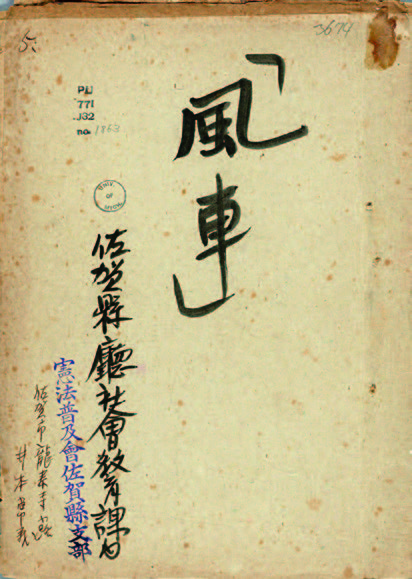
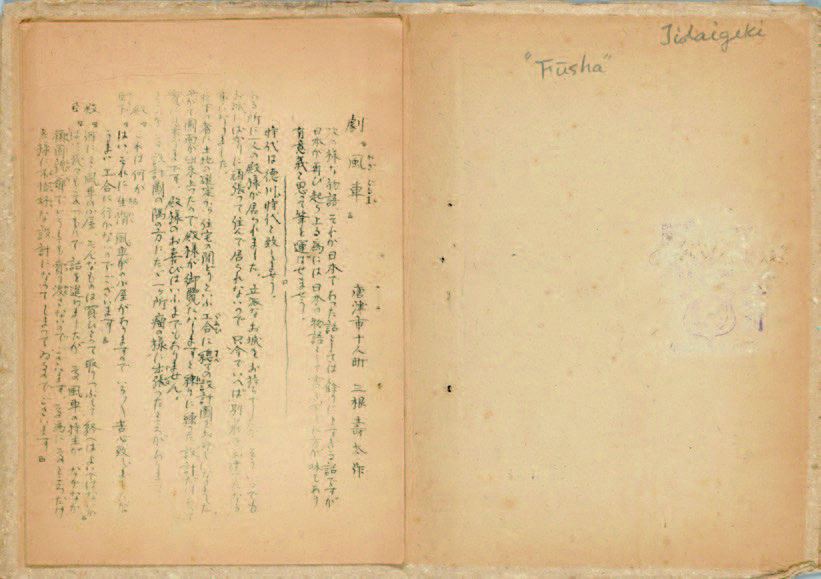
Kazaguruma [Windmill][GHQ03674]
Script for Kazaguruma. The playwright was a teacher in Karatsu.
The applicant was a local leader who had been the principal of
a higher elementary school until the war.
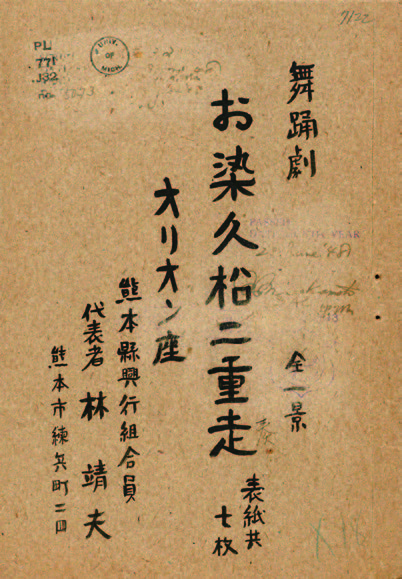
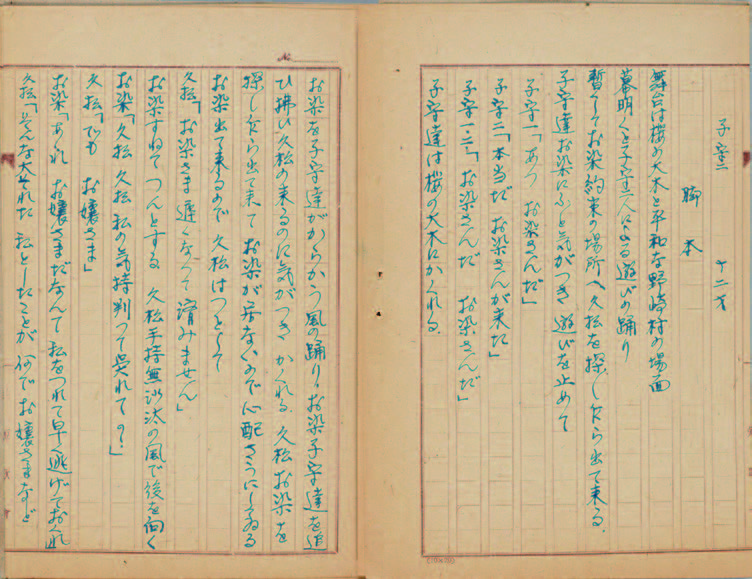
O-some Hisamatsu Nijuso [Flight of O-some and Hisamatsu][GHQ07122]
According to the April 14, 1947 Kumamoto Nichinichi Shimbun, this play was performed as an“ additional production” earlier
than the creation date of 1948 written on the script.
Selected Research 4
Research on Musicians and Musical Bands through Kurihara’s Musical Score Collection: Music for Stage and Cinema during the Early Showa Era
Principal Researcher
Nakano Masaaki (Professor, College of Humanities, Shukutoku University)
Collaborative Researchers
Shirai Fumito (Associate Professor, School of World Liberal Arts, Nagoya University of Foreign Studies)
Yamakami Yohei (Project Lecturer, Komaba Organization for Educational Excellence, The University of Tokyo)
Mori Masato (Independent Researcher)
Kojima Hiroyuki (Doctoral Program, Graduate School of Arts and Sciences, The University of Tokyo)
Research Objectives
Kurihara Shigekazu (1897-1983) was a musician active during the early Showa period in the Enoken Orchestra and Shochiku Kinema’s performance department, as well as the P.C.L. (Photo Chemical Laboratory) Film Studio in the early day of sound film. This study surveyed and analyzed musical scores formerly belonging to the Enoken Orchestra and Kurihara Shigekazu (approximately 1,000 items). Based on the results of the basic survey of sheet music materials conducted up to 2021, the research will proceed with a combined survey into contemporary documents and related sheet music collections. Through empirical research into the activities of Enomoto Ken’ichi (1904-1970) and the musicians and bands surrounding Enomoto and Kurihara, the goal is to clarify the production and creative process which occurred across contemporary theater, music, and film.
Summary of Research
〇 Cataloguing the Sheet Music and Survey of Related Documents
Regarding the catalog of approximately 1000 items for which basic information was obtained up through 2021, updates for the wider usage were made to provide information on composers, arrangers, individual musical pieces of uncertain provenance, etc. Furthermore, the study conducted a basic survey of the materials (Taito City Shitamachi Museum holdings) formerly owned by Shinohara Masao (1894-1981), a musician in contact with Kurihara, selecting materials closely related to the Kurihara holdings and completing the groundwork for a systematic comparative survey in the future.
The study also produced results with regard to tracing Kurihara’s work before the Enoken Orchestra. In addition to purchasing and investigating material from the Chitose Theater, a movie theatre in Nagoya where evidence exists that Kurihara worked briefly as a musician, a careful study of the theater’s programs (approx. 70 items) already in the Theatre Museum collection revealed hints to his early activities.
〇 Presentations of Related Research Outcomes and Public Seminar
Using the report on outcomes compiled in 2021, collaboration and sharing with experts in musicology and film studies continued. The principal researcher, Nakano and collaborative researcher Mori published books in related areas (respectively, Rosi opera to Asakusa opera [Rosi Opera and Asakusa Opera] and SP record nyumon [Introduction to 78-rpm records]. In addition, the collaborative researcher Shirai Fumito presented on film music from silent movies through early talkies at the 21st Quinquennial International Musicological Society Congress 2022 (Athens, Greece).
Using the research network formed in this way, a public seminar was conducted jointly with the Nagoya University of Foreign Studies World Liberal Arts Center in February 2023. Conducted jointly with the principal research 3 on “Research on Study Toward the Utilization of Film-related Materials Centered on Theater Flyers” the seminar investigated the diverse ways in which Western music and film culture developed and mixed with the local vernacular practices. Starting in particular with the reception of Western music in Nagoya, where the Ito Gofukuten Boys Music Band, to which Kurihara belonged, was launched, the member of the research groups gathered for research reports and discussion. Through an exchange of opinions with Nagoya-based experts and researchers, including Shichijo Megumi of the Aichi University of the Arts, the seminar proved to be an ideal opportunity to position Kurihara’s activities within the broader contexts of musical culture of the Taisho and early Showa eras, not limited in his activity in Asakusa and his collaboration with Enomoto.
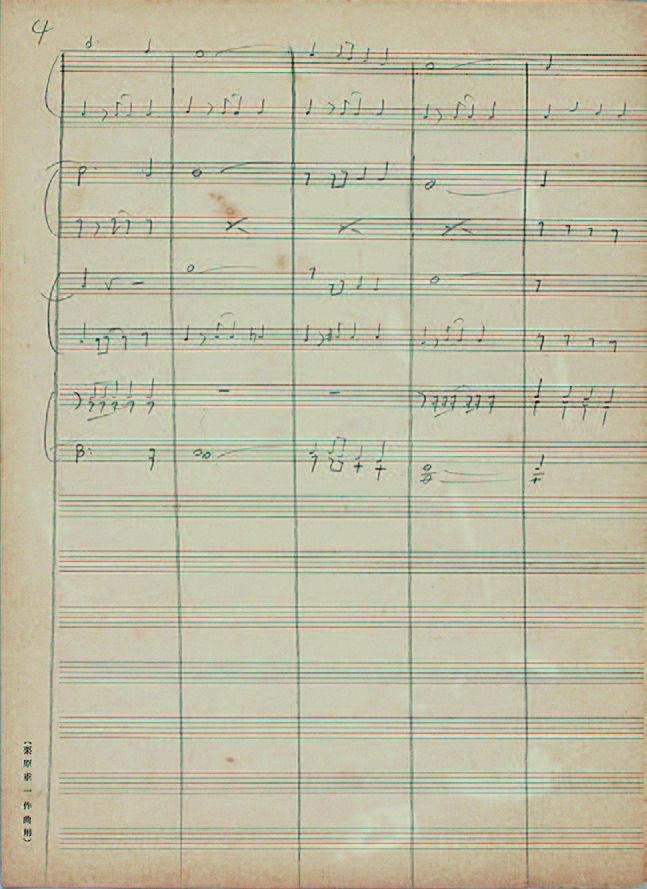
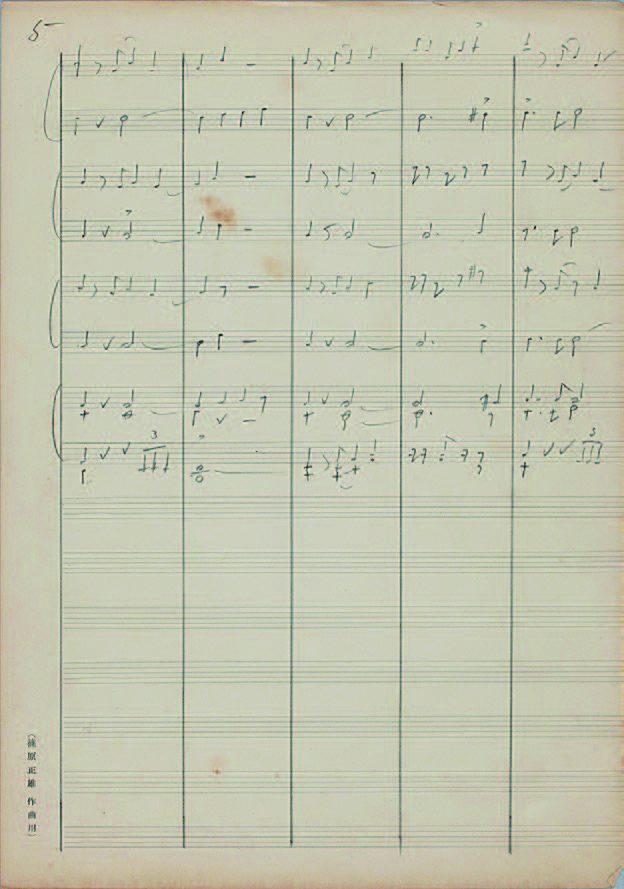
“Sheet music: Calling Donguri Tombei (original piece: Son
Cubano Rumba),” manuscript score[KRH47477]
Staff paper used: page 4“ for Kurihara Shigekazu’s compositions,”
page 5“ for Shinohara Masao’s compositions”
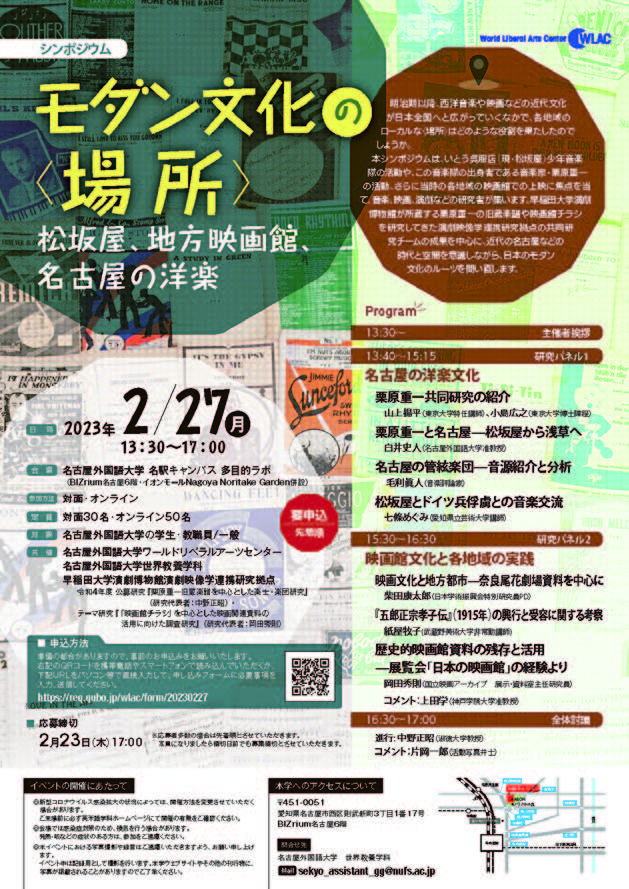
Flyer of the symposium in February 2023
Selected Research 5
Publishing Activities of the Sakagawaya, Publisher of the Original Tokiwazu-bushi
Principal Researcher
Takeuchi Yuuichi (Professor, Research Institute for Japanese Traditional Music, Kyoto City University of Arts)
Collaborative Researchers
Suzuki Eiichi (Adjunct Researcher, Theatre Museum, Waseda University)
Tsuneoka Ryou (Director, Tokiwazu Association)
Abe Satomi (Part-time Lecturer, Musashino Academia Musicae)
Maeshima Miho (Part-time Lecturer, Tokyo University of the Arts)
Shigefuji Gyoo (Part-time Lecturer, Edogawa University)
Konishi Shiho (Collaborative Researcher, Kyoto City University
Research Objectives
In 1860, near the end of the Edo period, the Sakagawaya inherited woodblock prints of the Tokiwazu from its original printer, the Igaya, for reprinting; it continued to release new editions from that point into the Showa era, printing original copies (rehearsal copies) from woodcuts up through 1987 or so. These woodblock prints are the woodblocks—approximately 800 research materials known as the Sakagawaya Tokiwazu-bushi original woodblock holdings—which were donated to the Theatre Museum. The research team has conducted bibliographic research in AY2020 and 2021, creating a title catalog as well as a detailed catalog for each text woodblock. In this academic year, the team focused mainly on woodblock with supplementary material such as title tags and colophons as well as woodblock sides, creating an ancillary catalog for these along with working toward a more multifaceted overview of the publishing work of the Sakagawaya.
Summary of Research
The main research outcomes for AY2022, as well as the ancillary catalog above, include a symposium on the topic of the Tokiwazu-bushi original woodcuts and the Sakagawaya’s publishing activities, held online on November 26, entitled “Studies of the Tokiwazu Joruri Print Woodblocks: From the Theatre Museum Sakagawaya Holdings.” Reports on research given at the symposium included Shigefuji Gyo’s overview of the woodcut survey status and issues, as well as Suzuki Eiichi’s testimony, which focused not only on his own encounter with Sakagawaya and their woodblocks but also on the circumstances and background of the people concerned with Tokiwazu-busi that led to the materials’ donation to the Theatre Museum. Furthermore, Takeuchi Yuichi introduced examples illustrating the connection between the published rehearsal books and the woodcuts, while Tsuneoka Ryo and Konishi Shiho described the performers connected with the modern and contemporary Sakagawaya. Further, two guest lecturers (Nagai Kazuaki and Kaneko Takaaki) spoke on Meiji-era woodblocks and copyrights, lecturing on the properties of the Sakagawaya woodblocks from the perspective of prior research on woodblock prints of text and pictures. Their discussion demonstrated the significance and importance of the Sakagawaya woodblocks as academic research materials. During the question-and-answer period, opinions were exchanged from various perspectives on the publishing activities and woodblocks of the Sakagawaya, led by Abe Satomi and Maeshima Miho.Regarding the Sakagawaya, we have records in the late-Edo Shotonya namae cho [List of Wholesalers] of the transfer of copyrights from Igaya Kan’emon (prior study by Takeuchi, 1996) and a resumé of the Sakagawaya owner listed in the 1927 Gendai ongaku daikan [Book of Modern Music], a list of performing names, but other than the Tokiwazu-bushi printed originals and their existing woodblocks, there are few direct records of the Sakagawaya owners and their publishing activities. This year’s symposium served to present new material such as newspaper articles on the inheritance and owner change of the Sakagawaya in the early Meiji era, recollections from performers of the Sakagawaya in the late 1970s and 1980s, its last days, and the existence of photographs belonging to relatives, but the individual points have not yet been connected to form an overall view. Information gathering and survey research is to continue in order to identify the periods of inheritance/ owner change, the respective owners and the employee trends, and the ups and downs in publication of the Tokiwazu originals.
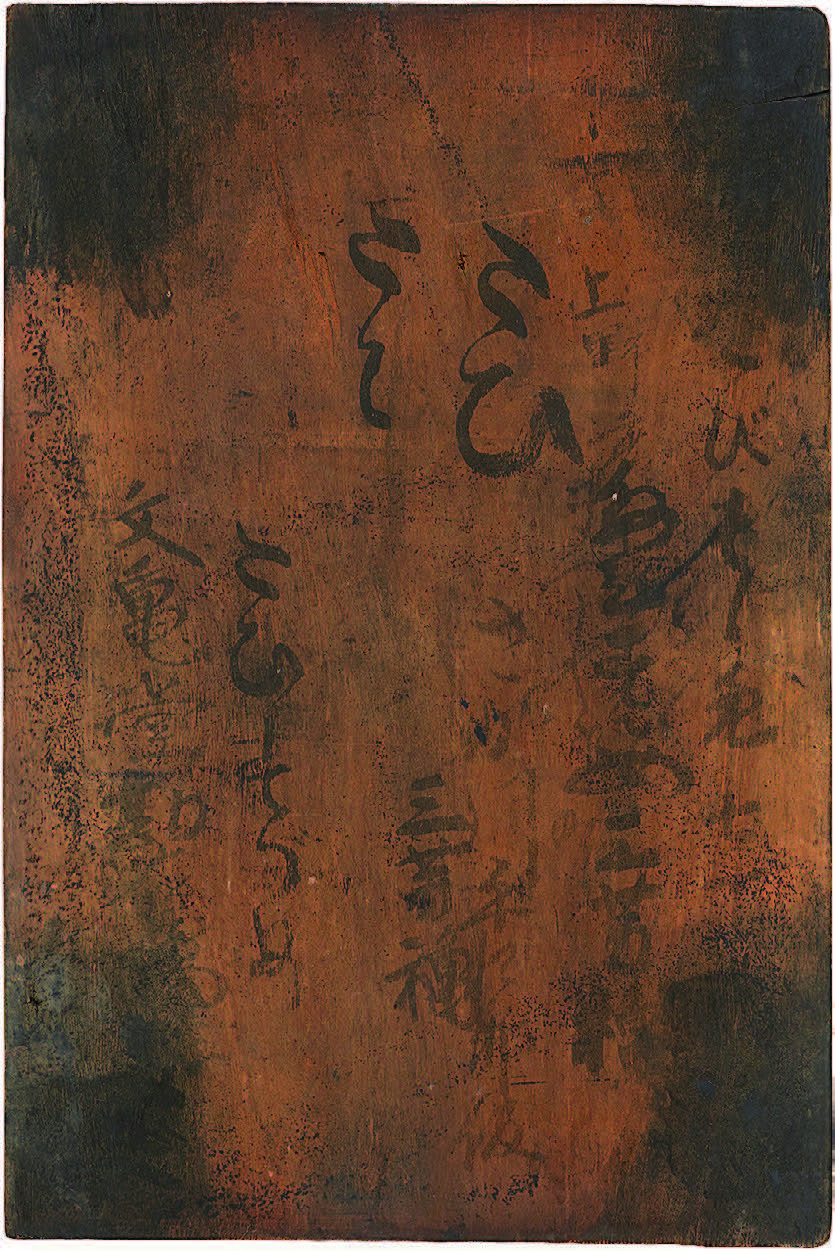
Investigation of the unengraved sides is also important. The photo shows the back of the last woodblock of the Tabisuzume miyoshi no irodoki rehearsal book (four text woodblocks, 7 lines, 7 sets; performed at the first Kawarazaki-za performance in September 1847). The Sakagawa woodblock holdings are composed of nichogake blocks enabling two-set printing; because of the number of blocks, some have engraving only on one side. The unengraved sides often have writing, which is also valuable for woodblock research. The text visible here is related to the title or to the printer; it is thought to have been used for notes as needed over many years. The ink stains at the corners are visible on a few other woodblocks as well, serving as hints to the actual printing process. Photographed in AY2022 during Centre research.[29888-169(08-11)]